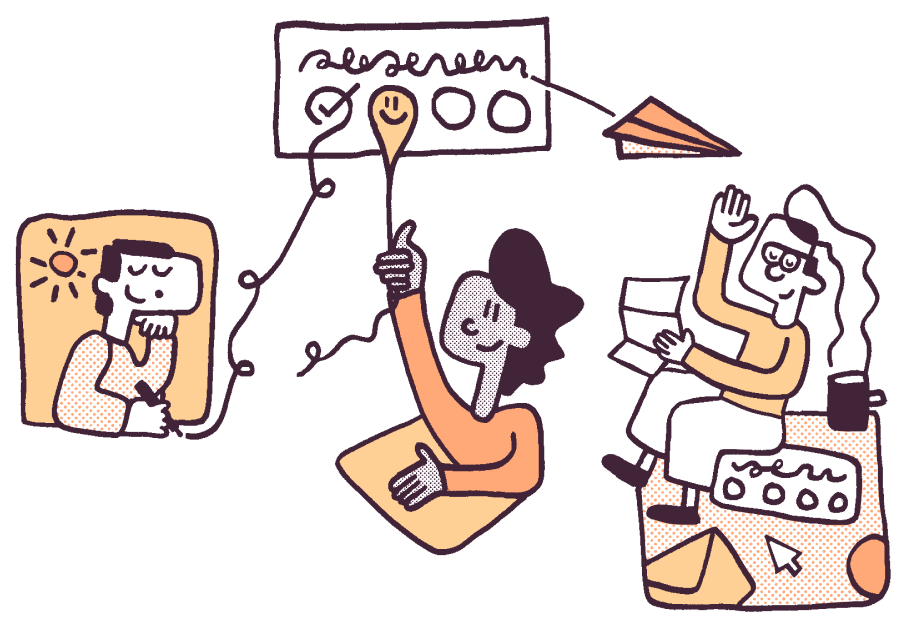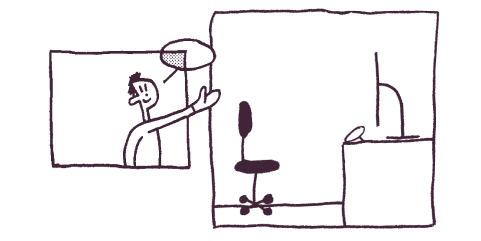THE ROI OF EMPLOYEE EXPERIENCE
Your business is your people
A happy, productive team makes for a thriving business. And it all starts with a carefully crafted and feel-good employee experience.
The question is: how much can you really save by investing in your employee experience? Answer three quick questions to find out.
INVESTing IN EMPLOYEE EXPERIENCE
Calculate your future wins

Over 8,000 businesses know that Officevibe is a smart investment
But first, what is EX (and why does it matter)?
Employee experience is the sum of all interactions team members have with an organization and how they observe, interpret, and internalize them. EX involves every touchpoint employees have from the moment they apply for the job until they part ways with the organization.
By nature, humans are deeply affected by our surroundings. It impacts our mood, motivation, productivity, and creativity, which affect our outputs. And before being employees, people at work, are after all, human.

The ROI of a great EX
The numbers don’t lie. Gallup surveyed 2.7 million employees and found that most vital and measurable business outcomes are impacted by employees’ engagement levels.
In this assessment, they found that the top 25% most engaged teams* benefited from:
- 81% Lower absenteeism
- 18% Higher productivity
- Between 18% and 43% lower turnover rates
- 10% Higher customer loyalty and engagement
* Compared to the teams in the bottom-quartile.
The costs of ignoring EX
If the flip side isn’t enough to convince you to invest in a positive employee experience, perhaps looking at the hard costs will.
Turnover
If you consider both hard and soft costs, employee turnover can cost three to four times an employee’s annual salary, depending on the nature of the position and the resources it takes to refill it. If it’s routinely swept aside, your turnover costs are compounding year-over-year – taking a toll on your business’s bottom line.
Disengagement
Disengagement costs include losses in productivity, absenteeism, and customer experience. Considering disengagement costs 7.8 trillion USD globally, or 11 % of global GDP, this cost is not negligible.
Ready to invest in your employee experience?
FAQs
What does my ROI indicator mean?
Your employee experience ROI indicator estimates the number of dollars you can save in disengagement and turnover costs per every dollar invested in employee experience.
What does it mean to invest in employee experience?
Investing in employee experience means taking a proactive approach to improving everyday interactions, touchpoints, and experiences employees face at your organization.
This includes, but is not limited to:
- Workplace culture
- Communication
- Tools and resources
- Career development
- Employee-manager relationships
- Health and wellness
The first step to improving EX is to know where you stand. Are you investing your resources and efforts wisely? A solution like Officevibe helps you measure all aspects of engagement with concrete insights from your employees, giving you a clear picture of your organization’s engagement so you know where to start.
How can I improve my employee experience ROI?
Improve your employee experience in four easy steps:
Step 1: Measure
To improve something, you must start with an accurate view of its current state. You can do so with pulse surveys, anonymous feedback, and one-on-ones – all of which can be found in one handy platform, like Officevibe.
Once you have quantitative (metrics and KPIs) and qualitative data (comments and notes to support or add color to the numbers), you can see where your gaps are, set your goals, and take action.
Step 2: Act
Measuring your EX tells you which areas are going great at your organization and those that need a little work. Keep the positive in check and concentrate the rest of your time and investments on addressing the areas needing improvement. For example, if stress metrics are on the rise, consider analyzing workloads and adopting flex hours.
Consulting your team and communicating your plan and intentions are both good ideas at this point.
Step 3: Measure Again
As in step one, measuring is critical to understanding what’s working and what isn’t. Assuming your action plan was effective will not guarantee a good employee experience. You need to remeasure it and compare your previous stats with your new ones.
Chances are your numbers will have improved, but you may also uncover new insights to further enhance your employee experience. Improving EX is an iterative process, so measuring and tracking your results over time is essential.
Step 4: Optimize
Once you reach step four, you will have already put in most of the work and effort. At this stage, it’s all about making minor adjustments that will go a long way. Doing so shows your employees you’re constantly listening to their feedback and working towards making their experience better.
How do I calculate my turnover rate?
Step one
Add the number of employees at the start of the year with the number you had at the end of the year.
For example: 20 employees at the start of the year + 18 employees at the end of the year = 38 employees.
Step two
Divide the total you got from step one in half (by 2).
For example: 38 total employees ÷ 2 = 19 employees.
Step three
Divide the number of employees who left during the year by the outcome of the first equation.
For example: 2 employees left during the year ÷ 19 employees = 0.105
Step four
Multiply this final number by 100, and you‘ve got your employee turnover rate.
For example: 0.105 × 100 = 10.5% turnover rate.
Curious to know more? Learn about the differences between employee retention and turnover and how to improve both.




